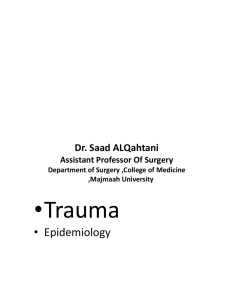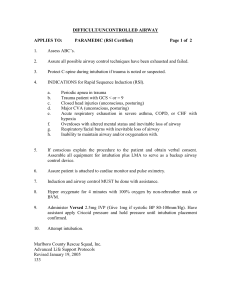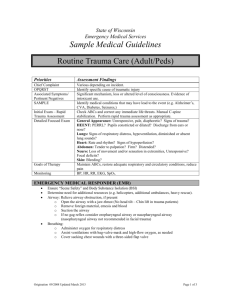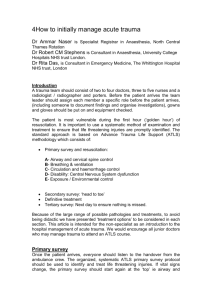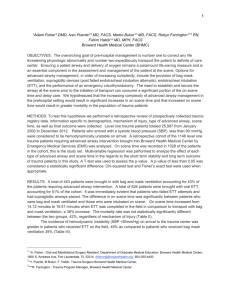here - EDventures
advertisement
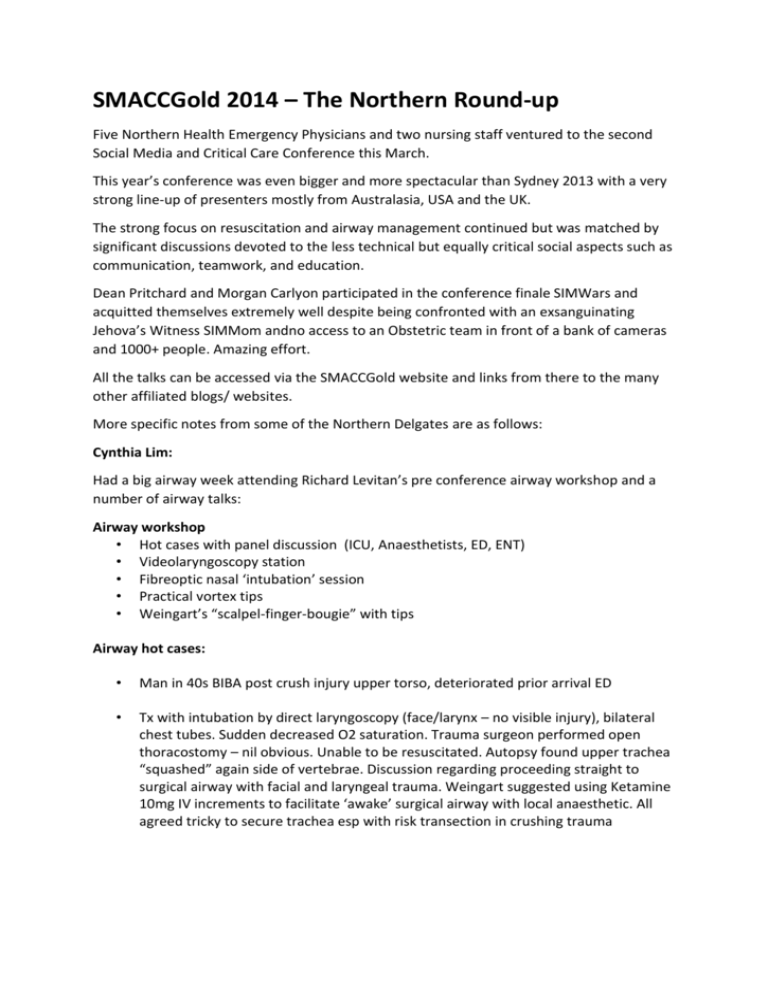
SMACCGold 2014 – The Northern Round-up Five Northern Health Emergency Physicians and two nursing staff ventured to the second Social Media and Critical Care Conference this March. This year’s conference was even bigger and more spectacular than Sydney 2013 with a very strong line-up of presenters mostly from Australasia, USA and the UK. The strong focus on resuscitation and airway management continued but was matched by significant discussions devoted to the less technical but equally critical social aspects such as communication, teamwork, and education. Dean Pritchard and Morgan Carlyon participated in the conference finale SIMWars and acquitted themselves extremely well despite being confronted with an exsanguinating Jehova’s Witness SIMMom andno access to an Obstetric team in front of a bank of cameras and 1000+ people. Amazing effort. All the talks can be accessed via the SMACCGold website and links from there to the many other affiliated blogs/ websites. More specific notes from some of the Northern Delgates are as follows: Cynthia Lim: Had a big airway week attending Richard Levitan’s pre conference airway workshop and a number of airway talks: Airway workshop • Hot cases with panel discussion (ICU, Anaesthetists, ED, ENT) • Videolaryngoscopy station • Fibreoptic nasal ‘intubation’ session • Practical vortex tips • Weingart’s “scalpel-finger-bougie” with tips Airway hot cases: • Man in 40s BIBA post crush injury upper torso, deteriorated prior arrival ED • Tx with intubation by direct laryngoscopy (face/larynx – no visible injury), bilateral chest tubes. Sudden decreased O2 saturation. Trauma surgeon performed open thoracostomy – nil obvious. Unable to be resuscitated. Autopsy found upper trachea “squashed” again side of vertebrae. Discussion regarding proceeding straight to surgical airway with facial and laryngeal trauma. Weingart suggested using Ketamine 10mg IV increments to facilitate ‘awake’ surgical airway with local anaesthetic. All agreed tricky to secure trachea esp with risk transection in crushing trauma Airway Hot Cases (cont.d) • Man in 60s admitted to ICU for asthma who deteriorated overnight. Reg performed RSI, laryngoscopy revealed laryngeal tumour obscuring vocal cords and obstructing AW. Anaesthetist rapidly attended and intubated with bougie and small ETT. Panel discussion recommended surgical airway and NOT attempt to intubate through tumour (bleeding risk, pushing tumour down airway/bronchial tree) Videolaryngoscopy – practical tips with toys • Use like standard laryngoscope then look at ‘video’ • Recommend use of bougie for all • For big chests, insert blade at 90degrees (i.e. handle and blade to patient’s right, then rotate to front • McGrath – small handle avoiding pitfall of patient with big chest and issue with insertion of blade. Con – battery finite and not rechargeable • King Vision – similar to McGrath with longer blade • Mac 3 – base battery/power unit with interchangeable blades (e.g. mackintosh, Millers) • New Mac D extra curved for trauma and ‘anterior’ larynx • Now comes in disposable Fibreoptic nasopharyngoscopy • Storz • Cophenylcaine spray • Tristal wipes for cleaning • Consider purchase of second-hand • Practical applications in ED – FB (esp pesky fishbones), airway burns Cut to air, Scalpel – finger – bougie • Weingartism • Airway anatomy and technique - midline is a safe place to go • Protected by posterior cricoid cartilage posteriorly and articular joints laterally • http://emcrit.org/smacc/airway-workshop-surgical-airway/ • Steady hands on patient’s sternum • If cannot locate anatomical landmarks, start at sternal notch and retract adipose tissue as cut with scalpel until cricothyroid membrane palpable • Palpate posteriorly cricoid cartilage, then feed bougie against fingertip till reach carina • Rotating size 6-6.5 ETT will enable easier passage • Blood loss minimal and easily controlled with direct pressure including accidentally cut vessels – video illustrating this The Vortex Vortex tips • Bag valve mask tips – enable better seal of mask to face with thumb and thenar eminence on mask and index to little fingers along jaw • Laryngeal mask – various types • NG tube opening – use bougie to stiffen laryngeal mask to prevent mask tongue kinking during insertion • Bougie • Pre-primed bougie with ETT • Once inserted bougie, let go and rotate ETT only clockwise to ease passage past overhanging epiglottis Airway tips from expert presentations: • Weingart • Palpate anatomy and mark ‘X’ on cricothyroid membrane on all patients prior intubation Levitan • Obese patient – sit patient upright, mandible forward, nasal high flow O2 • Apnoeic oxygenation with high flow nasal prongs at 15L O2 • Use pre RSI and during intubation until ETT secured • Reservoir of O2 posterior nasopharynx Greenland – 2 curve airway concept for predetermining airway difficulty • Anterior column – face shape, buck teeth/receding chin aka anterior larynx, Ludwig’s angina • Posterior column – neck movement • The actual airway - airway obstruction, FB • Obese/pregnant patient – CPAP to reduce atelectasis • Combination of BVM with PEEP valve and nasal cannulae most effective • Consider as standard for all intubations Aortic crisis – Rob Rogers • 50% miss rate no matter what we do! • Suprasternal notch US to view dissection flap at ascending and arch aorta • 5 tips to help not to miss • 70% have symptoms above and below diaphragm (e.g. 50yr old with severe neck pain and transient leg weakness) • Chest pain and another symptom (e.g. chest pain and severe leg pain) • Severe chest pain or back pain with intractable vomiting • Young patient with abdominal pain and hypertension • (most commonly Marfans or drug use) • Patient just looks bad! Status epilepticus – Oliver Flower - Intensivist • Change in definition • Currently seizure greater than 5 minutes, or 2 seizures back to back with minimal recovery time • Prior definitions of 30 minutes based on primate experiments whereby microscopic brain injury would be seen at half hour of seizure activity • Treatment • 1st line – Phenytoin – need to given enough and wait for enough time to allow effectiveness • 2nd line – GA with infusions of Midazolam/Propofol/Thiopentone • 3rd line – Kepra loading 2-3g with infusions • New – Lacosamide • Use of synergistic verapamil to increase CNS levels of antiepileptic • No evidence for efficacy of ketamine as yet Anaphylaxis • • • • • • • • • ?Change in clinical definition as often no skin alterations although listed with skin manifestations and either one of GIT/Resp or CVS May not be IgE mediated Pholcodeine – some structural similiarities with neuromuscular blockers – issue with anaphylaxis with 1st anaesthetics Chlorhexidine in urethral gels and other premade formulations IV Paracetamol – mannitol component in IV preparation is sensitising allergen No real true increase in anaphylaxis between: • shellfish and iodine • Egg and propofol (egg white allergy, and propofol made from yolk component) True increased risk correlation of red meat allergy with ticks and use of gelofusine To investigate do mast cell tryptase at 1/24, 4/24 and 24/24 Management algorithms – ANZAAG State of the art Cardiac arrest - Scott Weingart • • • • • • • • • • • Practise intubating during CPR in simulation More effective ventilation if attach to ventilator and set peak pressure limits to 100cm Minimise interruptions to chest compressions by: New See through analysis ECG monitors External CPR machines ‘Hands – on” defibrillation PCA trial (Resuscitation) – Adrenaline effective for ROSC Vasopressin not completely buried yet – JAMA 2013 – Vasopression and steroid some effectiveness for cerebral perfusion Adrenaline infusion dosing by diastolic BP approximately 40mmHg and arterial line RUSH – Rapid US for shock haemodynamics E-CPR – ECMO CPR (www.edecmo.org) Peter Papadopoulos: Trauma Karim Brohi @karimbrohi Professor/Trauma Director Royal London Hospital Trauma.org Ain’t got time to bleed Cannot just break a femur in a motorbike accident. Beware of broken foot and LOC ! Boot off on the race track = catastrophic event: ankle needs to rotate to lose your bootfemoral and pelvic #s !! Avoid : INR > 1.2 mortality doubles INR > 1.5 doubles again !! Acidosis , pH < 7.1 Hypothermia, T < 32 Haemostatic resuscitation involves: Early haemorrhage control Permissive hypotension Limited fluid infusions Target coagulapathy Acute Traumatic Coagulopathy (some pathophysiology) Clot strength rather than prolonged APTT is the problem : o Clotting factors are not low. o Diminished fibrinogen: often come in at ½ Normal decreases substancially Mx : cryoprecipitate can help maintain levels. o In addition increased fibrinolysis Body’s response to trauma: Haemorrhage Catastrophic organ dysfunction Sepsis Persistent inflammatory catabolism syndrome (PICS) Magnitude and duration of insult determines final outcome. Blood substitutes Chemicals : perfluorocarbons Carriers: substitute Hb, earthworm Hb, polyHb-Fg (fibrinogen attached) Components: platelet microparticles. Nothing ready for prime-time ATLS ADR VSE = vasopressin, steroid, BRAIN Aim for diastolic BP ≥ 40 use artline in resus ADR used to maintain diastolic BPs. RUSH protocol vs TOE ECMO CPR www.edecmo.org Peter Jordan: Paediatric Resuscitation Francis Lockie Paediatric Intensivist -PETS/ NETS Retrieval Director South Australia “Paeds resus should be like a big Mac…” i.e. consistent.. Preparation is key: Checklist pre RSI useful – done in rapid fire fashion takes little time Brief team pre RSI I'm going to do... Plan B is... Plan C is.. PEEP critical if using BVM (Should ban standard BVM) Decompressing the stomach pre RSI very helpful – may even preclude the need for RSI! Pain related to IO insertion in children well studied. Not v painful..pain scores 2.3/10 (less than standard IV) but..more painful once infusing fluids/ drugs. Do a VBG early in sick kids. Quality/ Adverse events/ Error Prof Stuart Lane – Intensivist – RNSH Sydney If you want to be an awesome doctor you have to be an awesome communicator.. Avoid euphemistic language. The hallmark of professionalism is integrity Critical reflection critical to professional development. Communication Professor Imogen Mitchell.. The Canberra Hospital - Director ICU Patient Centred Care improves outcomes: Patients like: Uniforms Patient advisors. Introductions Smiles Know your patients Find out what matters to them. Listen ECGs Dr Steven Smith Associate Professor EM Minneapolis USA @smithecgblog Dr Smith’s ECG Blog Hqmeded-ecg-blogspot NSTEMI - 30% have occluded coronary arteries @ PCA. ECG is extremely accurate Subtle changes commonly underappreciated - Many have subtle changes particulary ST segments. Most non ischaemic ECGs have subtle ST elevation at V2 & V3 at baseline.. If ST depression this is often abnormal and suggests acute ischaemia. ST depression in V2 and V3 is a STEMI equivalent. New validated formula to determine if ST elevation significant. Calculator on blog (see above) . R wave amplitude/ Voltages critical Smaller R = smaller ST changes Wellens means artery has been closed and is now open ST segment monitoring important If considering pericarditis ..should not see ST depression ECGs Stephen Smith (cont.d) Always look carefully at aVL – if ST depression - beware Don't let age dissuade. Even without Risk factors Posterior leads...often small voltages therefore smaller ST elevations..Not as sensitive as anterior leads but because ST elevation seen rather than depression Cardiology doctors more likely to recognise significance and take for PCA. De Winter Ts = ST depression followed by peaked Ts another STEMI equivalent Risk Factors for Acute Coronary Syndrome Simon Carley Professor Emergency Medicine Manchester Royal Infirmary @EMManchester Stemlynsblog.org Presented Case studies and Evidence that showed extremely poor correlation between traditional Risk Factors for Coronary Heart Disease and STEMI/ Major Adverse Cardiac Events/ Death. Similar findings in other conditions.. History of presenting symptoms much more significant. Take Home Message – Don’t discount the possibility of Cardiac Cause of Chest Pain (and other significant pathology) based on absence of traditional risk factors. Chest Pain Evaluation Louise Cullen EM Professor Brisbane @louiseacullen Discussion of Diagnostic Strategies for Chest Pain. (see other communication and Blog entry) Troponins are Excellent Biomarkers but strategies need to put in place to ensure lack of specificity does not lead to overdiagnosis. - Need more than a single troponin to add MI - Good history and ECG interpretation remains critical Antibiotic Use Jeffrey Lippmann Professor/ Intensivist Royal Brisbane Antibiotic resistance can begin <24/24 and can occur after 1 dose.. There are no current biomarkers proven helpful for initiating Antibioticsr rapid confirmation of bacteraemia.. 2-3 yrs from availability. Do not delay Antibiotics in severe sepsis But...think before using. Good clinical acumen key. Sepsis Scott Weingart Intensivist/ Emergency Physician Mt Sinai New York @EmCrit EMCrit.com Discussed experience form large ongoing multicentre study of Sepsis Protocol in NY hospitals. Process improvements can achieve <20% mortality for septic shock 95% gains are from simple process changes and education http://www.nejm.org/doi/full/10.1056/NEJMoa1401602 ARISE (Australasian) and PROMISE (UK) studies are nearing completion and will shed further light on this area. Some of the reported improvement in sepsis outcomes are due to Denominator shift i.e. Many more patients are being classified as having severe sepsis or septic shock due to increasing use of Lactate and use of elevated Lactate >4 to differentiate/ code these patients. i.e. Patients previously coded as pneumonia have become sepsis. Having a Code Sepsis is helpful Initial lactate measurement (VBG) is helpful for identification/ risk stratification but repeat lactates are not that helpful. Lactate clearance does not = survival Rebounders (Lactate) do badly. Antibiotics need to be immediately available. Most can be simultaneously infused. Most patients require 2 or 3 L balanced crystalloid fluid (if IVC collapsed) quickly then stop or slow down. If still shocked after 20-30ml/kg start vasopressors. (peripherally or centrally) Ricard et al..Criticalcaremedicine 2013 41(9):2108-15 Source control is critical when relevant- don’t delay theatre for further resuscitation. Invasive lines/ monitoring only needed if using vasoactive drugs. No-one knows the optimal target for MAP – Recent study comparing different goals showed no difference when a Target MAP of 65 was compared with MAP 85. No evidence for targeting MAP>65 "High versus Low Blood-Pressure Target in Patients with Septic Shock" http://www.nejm.org/doi/full/10.1056/NEJMoa1312173 Shock – Are BBlockers Useful? John Myburgh - Professor/ Intensivist RNSH Sydney Survival largely due to venous constriction Fluid of choice in septic shock is NorAdrenaline (semi-seriously) Different strategies required for compensated v decompensated shock. B blockers do not protect the heart from increased metabolic demand 1 x inadequately powered trial shows strong mortality benefit with esmolol. but….Don't believe in magic bullets.. BBlockers may have some beneficial immune-modulating action but we don’t know what that is and they cannot be recommended at present. Education Victoria Brazil Educator/ Researcher/ Emergency Physician Brisbane @SocraticEM Useful site with resources/ evidence in Medical education: www.bemecollaboration.com Education and behaviour change are closely aligned What works: Structured interventions Reminders,incentives, checklists Simulation Short, Low Volume, High frequency Involvement in care/ Integration Repeated interventions required Use of internal teams Audit and Timely feedback od progress Dogmalysis Dr Cliff Reid Director Sydney HEMS @cliffreid Resus.me.com Listed a number of resuscitation and airway assertions which have no evidence base or evidence contradicting their benefit: No useful association between gag reflex and aspiration risk Failure of needle cricothyroidotomy common (NAP4= 40%) Open cricothyroidotomy is now recommended. In kids... Can do tracheostomy or Cricothyroidotomy Sutures are helpful to elevate trachea. Biggest problem is delay or failure to act. Maternal arrest...just do LUSCS Good outcomes despite delays. It may not be too late. Acidosis does not cause low Cardiac Output Noradrenaline – can start peripherally if good large bore peripheral cannula in-situ: Requires close observation. Ricard – Critical Care Medicine. 2013 41(9):2108-15) Decreased LOC is not a Contraindication for NIV (with careful trial) Pulses are useless for BP estimation Evidence for Cervical Collars very weak- Collared patients are better off with 2-4cm head support.Whatever leaves face horizontal (if supine) or neck in neutral position. Can sit up w collar on if thoracic/ Lumbar spine not injured. Log rolling can be dangerous Do not routinely do a PR on awake trauma patients Permissive hypotension...no good outcome evidence. Optimise perfusion and tailor to individual case Ketamine at sedative doses more likely to cause euphoria than dysphoria. Morgs Carlyon: - introducing self, sitting down and listening to what pts have to say for a minute without interrupting #hellomynameis - ALL ivabs can be given at same time - FACEMS thrash a mean air guitar - john farnham gets drunk medicos rocking - ask patients what they expect (ie comfort vs cure) - no matter how hard you try, simwars will always fuck you up Having two team leaders to run a resus is an option to consider - the nurses can run the ACLS side of things (after all, its just following a flow chart, and the dopey nurses can surely do this) whilst the medical team leader works on reversible causes/advanced therapies.

